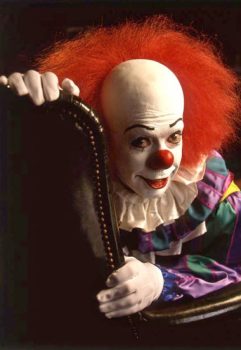Pennywise: The Dancing Monster
By Maureen McCabe
The horror genre is filled with genuinely scary monsters, but only a few of them go on to achieve cult status, terrifying generations of readers and viewers. One of the most chilling of these icons is Pennywise, the Dancing Clown. Created by Stephen King in his epic novel IT, and played to great effect by Tim Curry in the 1990 television miniseries, and Bill Skarsgard in the 2017 and 2019 movie versions of the book,


many people may think that Pennywise is the titular villain of It. In reality, he is really only one incarnation of a hideous, shape-shifting evil alien, but he is by far the most frightening. The creature wakes every 27-30 years to feed on human fears and flesh, preferring children as they are easier to scare and manipulate, before going into hibernation again. Stephen King has said in interviews that he chose to make Pennywise a clown after asking himself what children were most afraid of and deciding the answer was clowns. And even before King and John Wayne Gacy, there have always been people who have found clowns creepy and upsetting. There’s even a name for the condition: coulrophobia. At the same time clowns are supposed to be cheerful and fun for kids; they’ve been a staple of children’s programming and birthday parties for decades. Part of what makes Pennywise so distressing is this odd juxtaposition. He should be making children laugh with his playful antics and balloons, not preying on them.
Besides his off-putting appearance, humanoid but garishly painted, the way he moves and acts also contributes to his fiendish persona. Pennywise dances around and makes clown noises (beep beep) but even when he is trying to act his most benevolent, his gestures are always somehow just strange enough to be unsettling. His laugh ranges from gruff to skin-crawlingly diabolical. The most fearsome thing about Pennywise though, is his ability to know people’s innermost fears, and then use them against them. He manifests the things the young members of the Losers Club are most afraid of in horrific detail. Even when they are adults, his power to know which terrible images to summon is blood-curdling. It is only when the Losers are able to confront their fears, and overcome them, that they can hope to defeat him. King is of course famous for his ability to scare and thrill his readers, but he also really excels at deep character development in a way very few writers of any genre do. He gives his protagonists such wonderfully realized personalities that you come to truly care about them and their hopes and dreads. To see their childhood traumas and adult anxieties exploited so ruthlessly by Pennywise is quite moving. It is this level of intense psychological manipulation that sets Pennywise apart from other human-chomping monsters.

King brings Pennywise to nightmare-inducing life in the pages of It with all of his unparalleled skill. But Pennywise was also given mesmerizing portrayals by the actors that have played him in film and on TV. Bill Skarsgard has been justly praised for his more recent demonic version of Pennywise; Tim Curry’s was also quite petrifying back in the 90’s. Fans enjoying disputing which interpretation is better, or perhaps truer to their vision of the character. Skarsgard’s version is far more kinetic, and looks more menacing; his greasepaint is cracking and the black lines of his makeup are drawn more heavily. Curry’s Pennywise appears more like a traditional circus clown: he looks very much like Bozo or Ronald McDonald, albeit with gruesome fangs. But the rough, growl-like voice he employs, as well as the way he can make his eyes go from twinkling to dead flat, are quite scary, especially since his Pennywise depends solely on the actor’s performance, with no CGI involved. Once he is replaced in Part II of the miniseries with the supposedly horrifying giant spider, the fear quotient of the show quickly peters out. In It: Chapter II the filmmakers were careful to not make the same mistake: when the spider arrives to terrify the now adult members of the Losers Club, he has Pennywise’s head and his thorax is the clown’s torso. His herky-jerky movements echo Skarsgard’s dancing moves, which are madness turned to rhythm. Regardless of which performance you prefer, both actors do such a phenomenal job of bringing the demonic clown to life that their depictions must be credited with prolonging Pennywise’s reign of fright in people’s psyches.
And it appears that the world’s creepiest clown will have a new incarnation soon. Diehard fans who can’t get enough of Pennywise will no doubt be thrilled to know they will not have to wait 27 years for his reappearance. HBO has announced plans for a prequel series titled Welcome to Derry that explores how the murderous clown terrorized the small town in Maine prior to the events shown in the movies, proof that a great villain never truly dies.
Ratings:
Stephen King’s Novel It – 5 Snakes
It: 1990’s Miniseries Chapter One – 5 Snakes
It: 1990’s Miniseries Chapter Two – 4 Snakes
It: 2017 Movie – 5 Snakes
It: Chapter II 2019 – 4 Snakes







